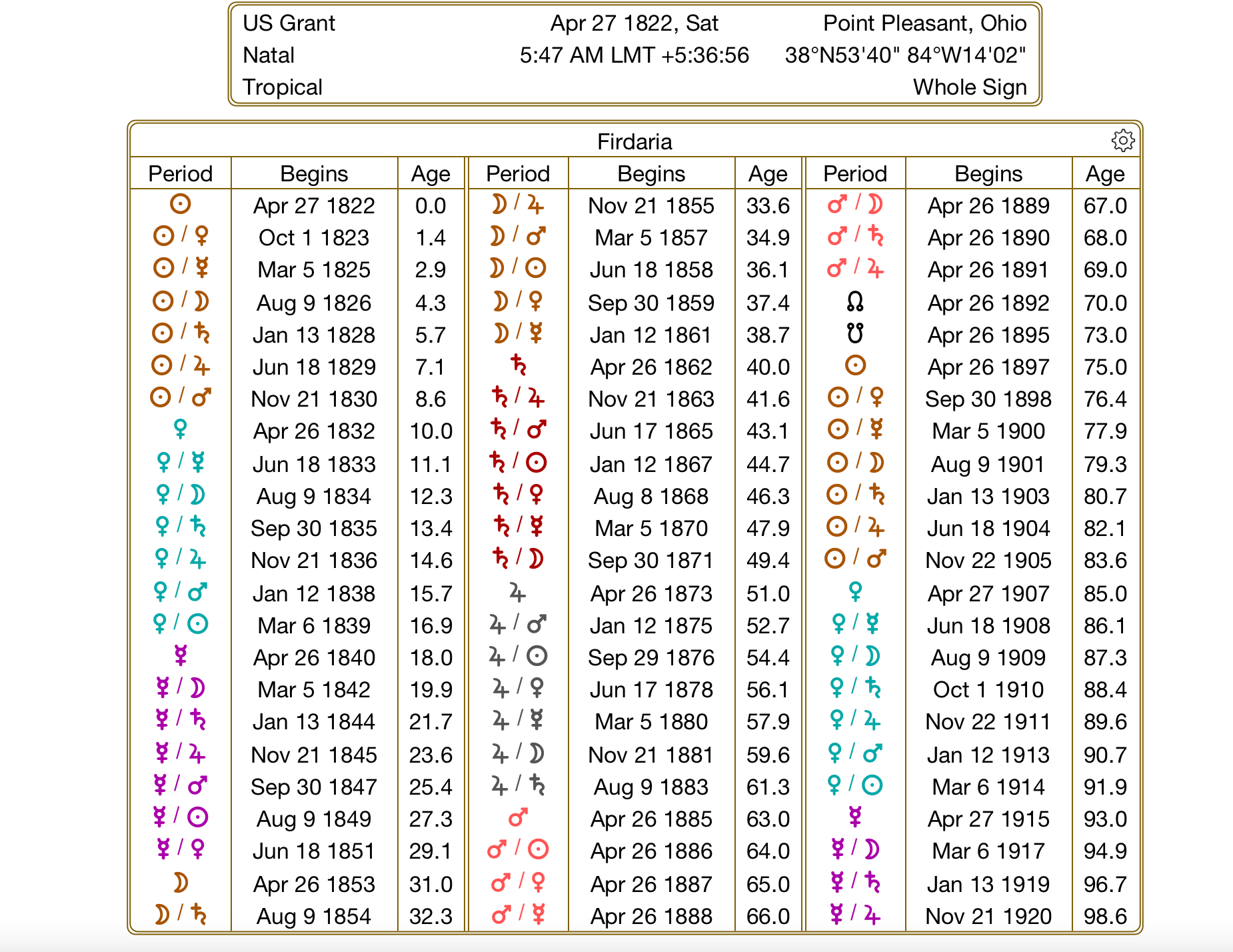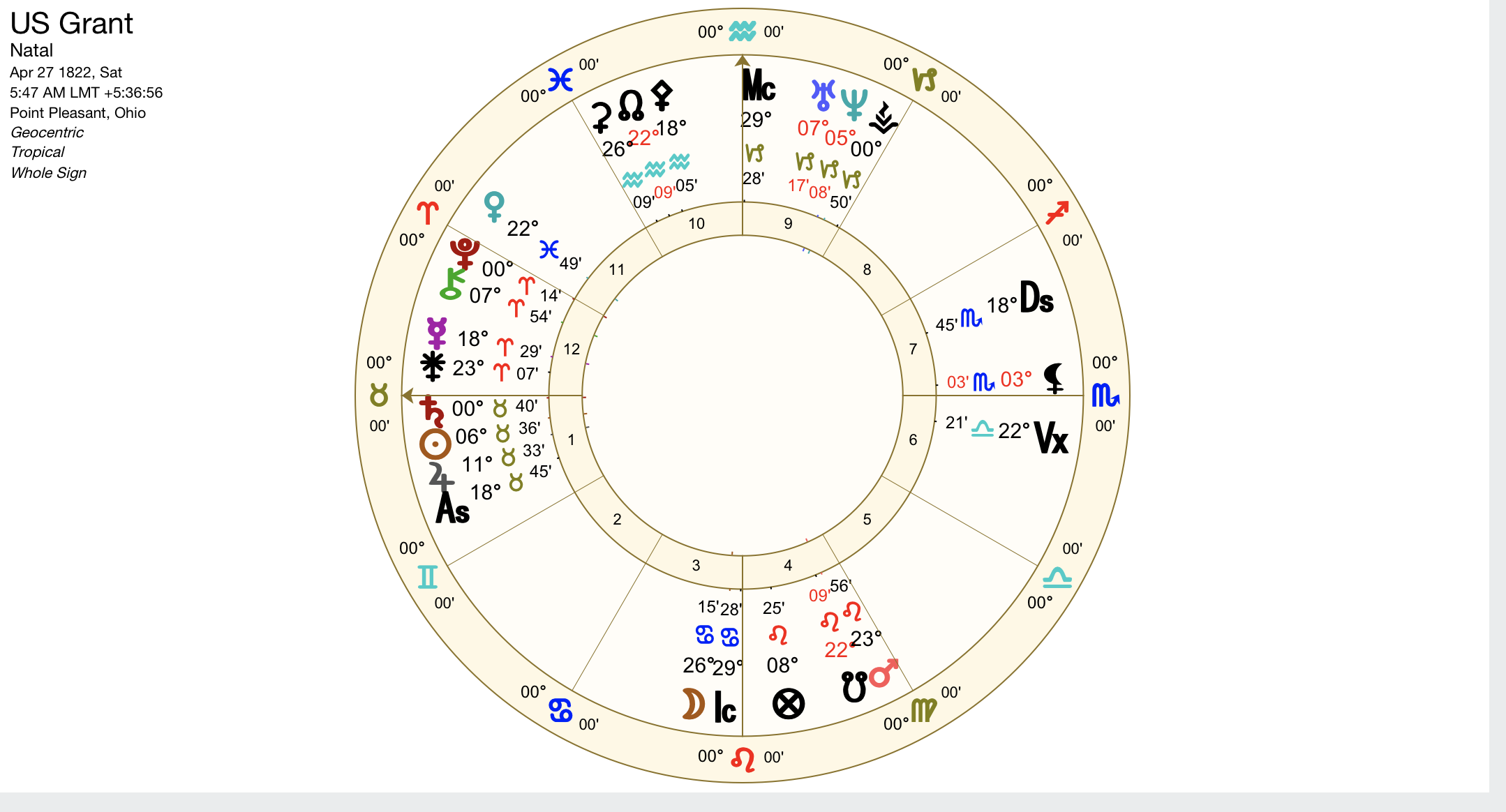“Then, indeed, I gave up all idea of saving the Union except by complete conquest.”
—U.S. Grant in his Personal Memoirs, in response to The Battle of Shiloh (April 1862)
This piece is the third (and final) in a series looking at astrological interpretation in the life of Gen. US Grant. The first piece looked at Grant's birthchart and the second the uncanny nature of asteroids. This piece will explore timing techniques.
All astrological timing techniques are second order processes—that is they always work off the birth (natal) chart. For an individual (or group entity like a business or country), the birth chart is primary. Think of the natal chart like a series of seeds implanted at birth in the soul. Timing techniques are ways of divining (with probability) when various seeds are most likely to fruit over the course of the life. Just growing a food garden, different seeds in a person’s chart will have different growing cycles.

The timing technique known as firdaria outlines planetary periods for one’s life. The exact origins of the technique remain a bit obscure (potentially Persian) but certainly has roots by the early middle ages. In fidaria there’s a major or overarching planet for a varying period of years: e.g. 7 for Mars, 10 for the Sun, 12 for Jupiter. Within that overall period there are 7 equal sub-periods with one of the traditional seven planets in “conversation” with the overarching planetary period, known as the Time Lord. For example, if Venus is the major period then there’s a Venus-Mars sub-period at a certain point (as well as Venus-Sun, Venus-Mercury and all the rest).
The system only works with the traditional seven planets. It follows what is known as The Chaldean Order which goes from slowest to fastest moving planet: Saturn, Jupiter, Mars, Sun, Venus, Mercury, Moon.
The first major planetary period is different for those born in the daytime (Diurnal) versus those born at night (Nocturnal). For Diurnal charts The Sun goes first, followed by Venus, Mercury, The Moon, Saturn, Jupiter, and then Mars. For Nocturnal charts the order is Moon, then Saturn, Jupiter, Mars, Sun, Venus, Mercury. For both day time and nighttime the meta cycle of all seven planets’ major periods lasts 70 years, followed by 5 years of The Lunar Nodes (3 North, 2 South) until 75. At which point, if the person is still alive, they start back at the beginning of the process.

Grant’s recorded time of birth is 5:47am in late April in Point Pleasant Ohio. That constitutes an in-between zone of daytime vs. nighttime chart. According to astronomical timing at that latitude and that time of year, Grant was born after astronomical and nautical twilight. The chart shows the Sun at 6 degrees in the first whole sign house with the Ascendant at 18 degrees—the Ascendant marks the horizon line so technically above (day chart) though very close. I think his life history rectifies best with a daytime chart (as I’ll argue below).
For each major period and sub-periods one looks to the various houses the planets highlighted exist in in the natal chart, which house(s) they rule, and the overall strength or challenge of the planet(s) in the chart to get a view of the outlines of that period of a person’s life.
The first major period I want to examine is that of Grant’s Mercury, which, like all Diurnal charts, starts at 18 (April 26, 1840). When Grant was 17 his father enlisted him at West Point military academy and at 18 he begins his years of schooling (Mercury). Grant’s natal Mercury is in his 12th house in the sign of Aries. His 12th House Aries configuration was mentioned in the prior article in relationship to Grant’s natal Pluto (death & rebirth) but here with Mercury, Grant literally is studying war: studying = Mercury; war = Aries, ruled by Mars god of war.
His Mercury however is in his 12th House—a place of boarding schools and isolation. He would later comment that the happiest days of his life were when he left both the US Presidency and West Point. In 1844 he meets his future wife Julia, during the Mercury-Saturn sub-period. Saturn, as we’ll see on numerous occasions, brings periods of prosperity to Grant’s life.
Grant then went from theoretically studying war to studying war in the flesh during the Mexican-American conflict which started in 1846, during Grant’s Mercury-Jupiter sub-period. Jupiter is another strong planet in Grant’s chart and he earns positive reviews for his bravery and leadership. On Sept 30, 1847 Grant transitions to his Mercury-Mars sub-period. Mars, as mentioned, is the god of war. Grant also described how he studied (Mercury) Generals Zachary Taylor and Winfield Scott (Aries/Mars war) during his war experience. Both his study of their leadership styles and his work as a quartermaster will serve him in his eventual rise to his own generalship. The war concluded in 1848.
After the war Grant continued in the Army and was sent to a number of posts between 1848-1853, including earning praise for organizing medical assistance during a cholera outbreak in Panama (1852, during his Mercury-Venus sub period.)
Then Grant is assigned to Ft. Humboldt in California in August 1853. By this point Grant has transitioned from his Mercury major period to his Moon major period. He enters his Lunar Time Lord phase on April 26, 1853. It will last until 1862.
Grant’s natal Moon is in Cancer, the sign of its rulership. His moon is conjunct the IC (Imum Coeli), an aspect of home and close family life. Cancer, the sign his Moon is in, is the sign of emotional closeness and togetherness. His family was unable to accompany him, directly rubbing against the Moon in Cancer conjunct the IC. Grant falls into a severe depression and begins drinking. The firdaria Moon years (his 30s) are the lowest of the low for Grant. Conjunct the IC, his moon is therefore opposite his MC (career marker). This firdaria period corresponds to his low point (opposition) career and life direction-wise (MC).
That Moon period concludes with a Moon-Mercury sub-period starting on Jan 12, 1861. Jan 1861 is just months after the election of Abraham Lincoln, the beginning of secession, and months before the outbreak of the US Civil War at Fort Sumter (April 1861). Grant’s study of war (Mercury) will now come back online and begin to pull him out of the funk he was in for much of his thirties.
April 26, 1862, the day before Great turns 40, he shifts into his Saturn major period. During this period he will ascend to the heights of power: overall command of The Union Army; ultimate victory in the Civil War; leading the Army in the post-war occupation of The South; and winning the US Presidency (for the first of two terms) in 1868. It is a nearly unbelievable trajectory.
By April of 1862 Grant had already won his first victories at Forts Henry and Donelson which had taken place a few months earlier. April 6—just three weeks before his changeover—is the brutal Battle of Shiloh which is a very costly victory for Grant. Yet a victory it is. And it sets him up for the Vicksburg campaign. (See the 2nd piece for the asteroids associated with these battles.)
Saturn, as I explored in great detail in the first piece in this series, is of ultra-importance to Grant’s chart, being born with Saturn at his 0 degrees of his first house (house of identity). From April 1862 to Nov 21, 1863 Grant in his overall Saturn period with the Saturn sub-period as well (Saturn-Saturn), a sort of double dose of Saturn. It is during this phase that he secures the total surrender of the Confederate army at Vicksburg, often considered his most ingenious campaign.
On Nov 21, 1863 Grant enters the Saturn-Jupiter sub-period. Jupiter is another powerful blessing planet in Grant’s chart. During this sub-period, with Jupiter inside Saturn’s overall command, we get a glimpse of things that will come to further fruition when Jupiter becomes the primary firdaria planet (1873-1885). Just days after the change to this sub-period, Grant leads the US Army in The Battle of Chattanooga which is yet another victory. A few months later President Lincoln promotes Grant to Lt. Gen, head of all US forces (Jupiter = king).
The rest of this Saturn-Jupiter sub-period includes The Overland Campaign and his eventual final victory in the Civil War. Robert E. Lee met Grant at Appamatox Courthouse, signing the surrender treaty, on April 6, 1865.
The Saturn-Jupiter sub-period ends on June 17, 1865 just a few months after Lee’s surrender. The next sub-period is Saturn-Mars, during which Grant receives the newly created title of General of the Army of the United States. A more martial (Mars) title, granted by the government (Saturn) one could not find.
In Jan 1867, Grant moves into the Saturn-Sun sub-period. During this period, friction arose between Grant and President Johnson—Lincoln’s Vice-President who assumed the office upon Lincoln’s assassination. The US Congress actually passed an act giving Grant (as Army Chief) de facto veto over President Johnson’s choices. Grant’s Sun was outshining the President, with Grant taking on an almost Presidential (Saturn) like power. It was during this period that Grant and Johnson formerly broke, after Grant became increasingly frustrated (like so many) with Johnson’s failures. Grant was most definitely at this point contemplating running for presidency (Saturn-Sun).
Grant wins election to the US Presidency in his Saturn-Venus sub-period which commenced in August 1868, a few months prior to the election. Grant’s Venus connected him to Lincoln. As detailed in the second in this series, the asteroid Lincoln is conjunct Grant's Venus (22 Pisces). Venus is a benefic planet, in exaltation in the sign of Pisces in his 11th house the house of friendship, alliances, and networks.
Grant wins re-election in 1872 just before entering his Jupiter major fidaria period which began on April 26, 1873. His completes his second term in his Jupiter-Sun sub-period (1877) as he rides off into the setting sun, a period of more public retirement, beginning with a long voyage. During the rest of the Jupiter major period years, Grant experiences financial difficulties in his post-presidential years. His public image began to be rehabilitated after some scandals (not of his doing but of subordinates) during his presidency dinged his image.
His final period of his Jupiter firdaria is a Jupiter-Saturn sub-period. During this period (1884) he was diagnosed with cancer—probably from smoking, i.e. a respiration issue (Saturn). Given the financial challenges, Grant took to writing his memoirs, even with the increasingly excruciating pain he was in, as he was more and more confined in his movements (Saturn = restriction). Saturn the planet so crucial to his birth and identity (0 degrees, 1st house) would also be intricately tied to his death (0 degrees first house, bordering on the 12th house spirit world).
In April of 1885 Grant transitioned to his Mars major period, which, as it turns out, was only to last but four months as he would be dead by July of that year. Mars is the warrior and Grant soldiered on through brutal physical ailments, all in a rush to finish the memoirs so his wife and family could be supported after his death. His memoirs are that of a general (Mars). As noted previously his Mars is conjunct his South Node, the place of decrease. Here the decrease in health and eventually life itself.
Grant, true to his Saturnian committed, disciplined, and dogged self, finished the memoirs just days before dying. The warrior could finally be at rest.


